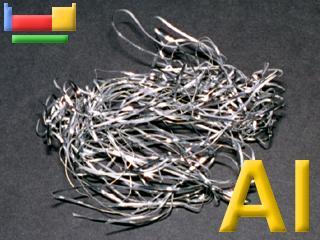The name aluminum is derived from the ancient name for alum (potassium aluminum sulphate), which was alumen (Latin, meaning bitter salt). Aluminum was the original name given to the element by Humphry Davy but others called it aluminum and that became the accepted name in Europe. However, in the USA the preferred name was aluminum and when the American Chemical Society debated on the issue, in 1925, it decided to stick with aluminum.
Aluminum is a soft and lightweight metal. It has a dull silvery appearance, because of a thin layer of oxidation that forms quickly when it is exposed to air. Aluminum is nontoxic (as the metal) nonmagnetic and non-sparking.
Aluminum has only one naturally occurring isotope, aluminium-27, which is not radioactive.
Applications
A silvery and ductile member of the poor metal group of elements, aluminum is found primarily as the ore bauxite and is remarkable for its resistance to oxidation (aluminum is actually almost always already oxidized, but is usable in this form unlike most metals), its strength, and its light weight. Aluminum is used in many industries to make millions of different products and is very important to the world economy. Structural components made from aluminum are vital to the aerospace industry and very important in other areas of transportation and building in which light weight, durability, and strength are needed.
The use of aluminum exceed that of any other metal except iron. Pure aluminum easily forms alloys with many elements such as copper, zinc, magnesium, manganese and silicon.
N early all modern mirrors are made using a thin reflective coating of aluminum on the back surface of a sheet of float glass. Telescope mirrors are also coated with a thin layer of aluminum.
Other applications are electrical transmission lines, and packaging (cans, foil, etc.).
Because of its high conductivity and relatively low price compared to copper, aluminum was introduced for household electrical wiring to a large degree in the US in the 1960s. Unfortunately problems on the functioning were caused by its greater coefficient of thermal expansion and its tendency to creep under steady sustained pressure, both eventually causing loosening the connection; galvanic corrosion increasing the electrical resistance.
The most recent development in aluminum technology is the production of aluminum foam by adding to the molten metal a compound (a metal hybrid), which releases hydrogen gas. The molten aluminum has to he thickened before this is done and this is achieved by adding aluminum oxide or silicon carbide fibers. The result is a solid foam which is used in traffic tunnels and in space shuttle.
|
